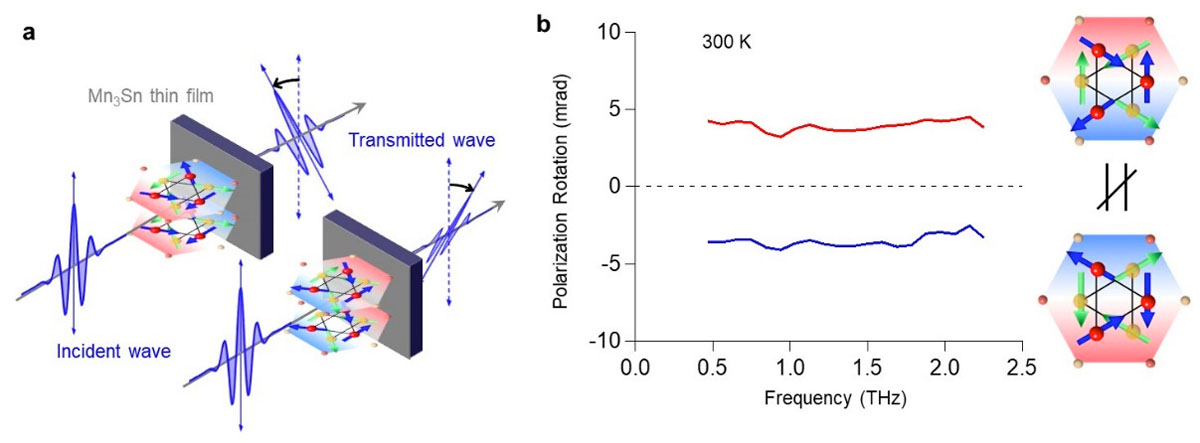Observation of Terahertz Anomalous Hall Effect in Weyl Antiferromagnet Mn3Sn Thin Films
Matsunaga and Nakatsuji Groups
Control of magnetism has been a key issue for modern data processing and recording in spintronic devices. From the viewpoint of manipulation speed, antiferromagnets are promising materials because spin precession motion occurs typically at terahertz (THz = 1012 per second) frequencies, a few orders of magnitude higher than ferromagnets. Readout of the magnetization information in antiferromagnets is, however, still very difficult since they are generally not sensitive to the external field because of the much smaller net magnetization than in ferromagnets, which has made their practical application challenging. In 2015, Nakatsuji group in ISSP has discovered large anomalous Hall effect (AHE) in an antiferromagnet Mn3Sn at room temperature comparable to ferromagnets in spite of the vanishingly-small net magnetization [1]. The exceptionally-large response originates from an inverse-triangular spin structure where the spins form a 120-degree order with negative vector chirality in the ab plane. Such noncollinear antiferromagnetic spin order in the Kagome bilayer is characterized by cluster magnetic octupole moments, which macroscopically breaks time-reversal symmetry. Deep understanding of the dynamical properties of Mn3Sn in the THz frequency range is highly desired for ultrafast readout of the antiferromagnetic spin order to develop novel functional devices.
In another point of view, Mn3Sn has also been interested as a possible candidate for Weyl semimetals with broken time-reversal symmetry, or “Weyl (antiferro)magnets”, which host massless electron dispersions with opposite chirality in the vicinity of the Fermi energy [2]. Since the ac anomalous Hall effect is directly related to the interband excitation across the Weyl nodes, a number of theoretical efforts have been recently devoted to investigating the ac anomalous Hall conductivity in σxy(ω) Weyl semimetals. Investigating σxy(ω) experimentally is therefore important for understanding novel electromagnetic responses related with the Berry curvature in Weyl semimetals.
Frequency dependence of the AHE can be observed in an optical method by measuring the polarization rotation of transmitted light. It is based on the relation between σxy(ω) and the polarization rotation angle θ(ω):
where η(ω) an ellipticity angle, d the film thickness, Z0 the vacuum impedance, ns the substrate refractive index, and σxx the longitudinal conductivity. In the present work, we developed polarization-resolved THz time-domain spectroscopy setups with precise polarization resolution up to 0.05 mrad in 0.5-2.0 THz frequency window for 20-min accumulation time [3]. Figure 1(a) shows a schematic of our measurement. Using Mn3Sn thin films with 50-200 nm thicknesses [4], we clearly observed the polarization rotation of transmitted THz wave at room temperature and zero magnetic field as shown in Fig. 1(b), depending on the direction of the cluster magnetic octupole moments. The result quantitatively agrees with the large AHE previously reported in the DC resistivity measurement.
We also performed the polarization-resolved THz spectroscopy with broad band frequency range up to 6 THz (25 meV) [3]. Figure 2(a) shows the result of real- and imaginary-part σxy(ω), corresponding to the non-dissipative and dissipative Hall current, respectively. The results demonstrate small dissipation in the AHE up to THz frequencies, which is consistent with an intrinsic origin of it. Figure 2(b) shows the temperature dependence of σxy(ω). The strong suppression of σxy(ω) below 250 K is consistent with the spin-reorientation phase transition from the inverse-triangular structure to a helical spin ordering along the c-axis. The development of the helical spin ordering along the c-axis recovers the macroscopic time-reversal symmetry, which results in the disappearance of the AHE.
The observation of the THz AHE at room temperature demonstrates the ultrafast readout for the antiferromagnetic spintronics using Mn3Sn. Our all-optical approach in a noncontact way with picosecond time resolution also opens a new avenue for studying nonequilibrium dynamics in Weyl antiferromagnets.
References
- [1] S. Nakatsuji, N. Kiyohara, and T. Higo, Nature 527, 212 (2015).
- [2] K. Kuroda et al., Nature Mater. 16, 1090 (2017).
- [3] T. Matsuda, N. Kanda, T. Higo, N. P. Armitage, S. Nakatsuji, and R. Matsunaga, Nature Commun. 11, 909 (2020).
- [4] T. Higo, D. Qu, Y. Li, C. L. Chien, Y. Otani, and S. Nakatsuji, Appl. Phys. Lett. 113, 202402 (2018).



